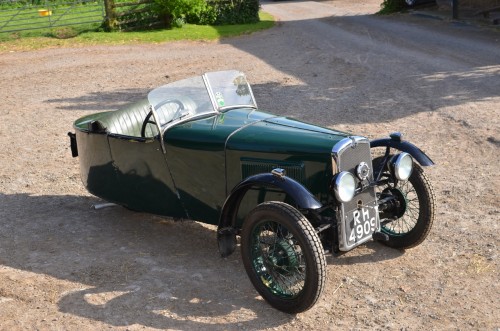
Click Here for Full Screen Image - Click Here to Download Image
 |  |  |  |  | |||||
 |  |  |
| Lot number | 99 |
|---|---|
| Hammer value | £11,000 |
| Description | BSA 3-wheeler |
| Registration | RH 4909 |
| Year | 1932 |
| Colour | Green |
| Engine size | 1,021 cc |
| Chassis No. | 2991 |
| Engine No. | SH 3154 |
In its time, the Birmingham Small Arms Company (BSA) manufactured all manner of items from bicycles to buses and firearms to machine tools, not to mention motorcycles and motorcars.
The first prototype car was produced in 1907. The following year, marketed under BSA Cycles Ltd, the company sold 150 automobiles. The first BSA cars were conventional rear-wheel drive machines, manufactured in Birmingham from 1907 and then in 1912 from a factory in Coventry. Car production ceased entirely throughout the First World War.
In 1921 BSA car production resumed with a rear-wheel-drive air-cooled 1080cc V-twin 10hp light car, followed by four-cylinder and six-cylinder models up to 1926, when the BSA name was temporarily dropped. A couple of years later BSA reappeared and from 1929 the company, now merged with Daimler, turned its attention to front-wheel drive three-wheelers. Though commonplace now, powering the front wheels was relatively novel, Alvis being one of the few other companies at that time experimenting with front wheel drive.
The engine was based on the Hotchkiss designed air cooled V-twin and was RAC rated at 9hp, as used in the conventional rear wheel drive BSA of 1922. It drove through a conventional three-speed gearbox to a differential mounted midway between the front wheels and thence by shaft, flexible couplings and additional joints to the front wheels. BSA combined this configuration with such niceties as independent front suspension, a reverse gear, electric start and full weather protection. Despite the innovative engineering, the weight was kept within the 8cwt taxation limit for three wheelers.
The new BSA was well received by the public and the press alike, furthermore, Motor Cycle magazine concluded that “The details of this vehicle are of such interest that it may be said to mark a milestone in the history of the light runabout”.
It was intended that the BSA machine should challenge the Morgan three-wheeler for that sector of the market and whilst the company achieved some success, BSA never seriously threatened Morgan’s dominance or its considerable reputation as the ultimate high-performance Cyclecar.
BSA car production throughout the inter-war years was always a secondary activity alongside motorcycle production which was the mainstay of the business. Three-wheelers continued until 1936 with car production under the BSA name ceasing in 1940 with the advent of the war.
This handsome example was first registered in March 1932 and spent much of its early life in Scotland. A continuation buff logbook shows that it resided in the Dundee area in the 1950s, surfacing at an auction sale in 1989 in nearby Angus. Correspondence from the BSA Club includes a photocopy of 'The Book of the BSA Scout and Three Wheeler' and an original instruction book is also in the file.
It joined the Stondon Collection in 1994 and was last MOTd in 1992, its tax expiring in 1993. It has an old style V5 and a current V5C which shows that its number RH 4909 is non transferable.
Fun, simple, entertaining to drive and with a fair turn of speed, these BSAs have become popular of late as enthusiasts have realised what excellent value they represent compared to a three wheeler Morgan of the same period.